Can You Use AI Chatbots for Keyword Research?
Yes, you can use AI chatbots for keyword research. But it’s important to understand the technology’s strengths and weaknesses before getting started.
Generally, AI chatbots are good at identifying common terms found in written content because they learn from large datasets.
Chatbots are also good at understanding keyword meanings and relationships, thanks to their natural language processing and machine learning algorithms.
That means you can ask a free chatbot like ChatGPT to provide keyword ideas based on a particular topic and get good results.

You can also ask AI chatbots to analyze search intent, group keywords into clusters, and complete some other keyword research tasks.
So, using AI for keyword research can help you save time and cut costs.
However:
AI chatbots don’t know what people actually type into search engines.
Unlike traditional keyword research tools, chatbots don’t have direct access to search engine data.
That means chatbots can’t reliably tell you how popular a keyword is or how difficult it is to rank for. And this can make it hard to prioritize keywords effectively.
That’s why many marketers use AI tools in combination with traditional keyword research tools—something I’ll talk more about later.
5 Free Chatbots for AI Keyword Research
You can use chatbots like ChatGPT, Claude, Gemini, Perplexity, and Copilot as free AI keyword research tools.
Here are some quick tips for success with any of those options:
- Write clear, conversational prompts and include any relevant context
- Upload supplementary files when possible and relevant
- If the tool has web access, consider asking the tool to refer to your and your competitors’ domains for information
- Remember that AI chatbots can hallucinate (provide false information)
- Refine the output by providing clear follow-up prompts
- Experiment with different models, search settings, etc., to see what gives the best results
Below, I’ll show you how each tool responded to AI keyword research prompts tested in March 2025. To give you a feel for the tools’ capabilities.
Just bear in mind that your results will vary.
ChatGPT
I asked ChatGPT to provide keyword ideas for a blog post about AI keyword research, and the chatbot provided 30 keywords split into three lists:
- Primary Keywords (High-Impact)
- Long-Tail Keywords (Niche & Conversational)
- Related Keywords (Supporting Topics)

Overall, the keyword suggestions were relevant and could provide great inspiration to a content creator.
However, I wouldn’t recommend using more than one primary keyword per post. And some of the primary keyword suggestions deviated from the main topic.
I followed up by asking ChatGPT to evaluate the intent behind someone searching “AI keyword research.”
The tool provided suggestions based on the four main types of search intent: informational, navigational, transactional, and commercial. So, this didn’t really narrow down my options—I’d need to do additional work to determine the best approach for my content.

These outputs demonstrate that you need a good grasp of keyword strategy basics to get the most out of AI keyword research. Just like you do with traditional keyword research.
Claude
David Bell, Co-Founder of Previsible SEO, recommends using Claude for AI keyword research due to its reliability and high-quality output.
Here’s a prompt Bell recommends for generating keyword ideas for an article:
“You are an seo analyst looking to write a content piece around [topic]. Can you perform keyword research and find patterns of used words that might benefit in the creation and overall performance of this piece. I’m adding a screenshot of what is ranking on page 1 on Google.”
Bell also attaches a screenshot of the Google search engine results page (SERP) for his target keyword, so Claude can gather insights from the top-ranking results.

Claude provided a variety of useful information, including:
- A list of core terminology
- Questions people are asking
- Content structure recommendations
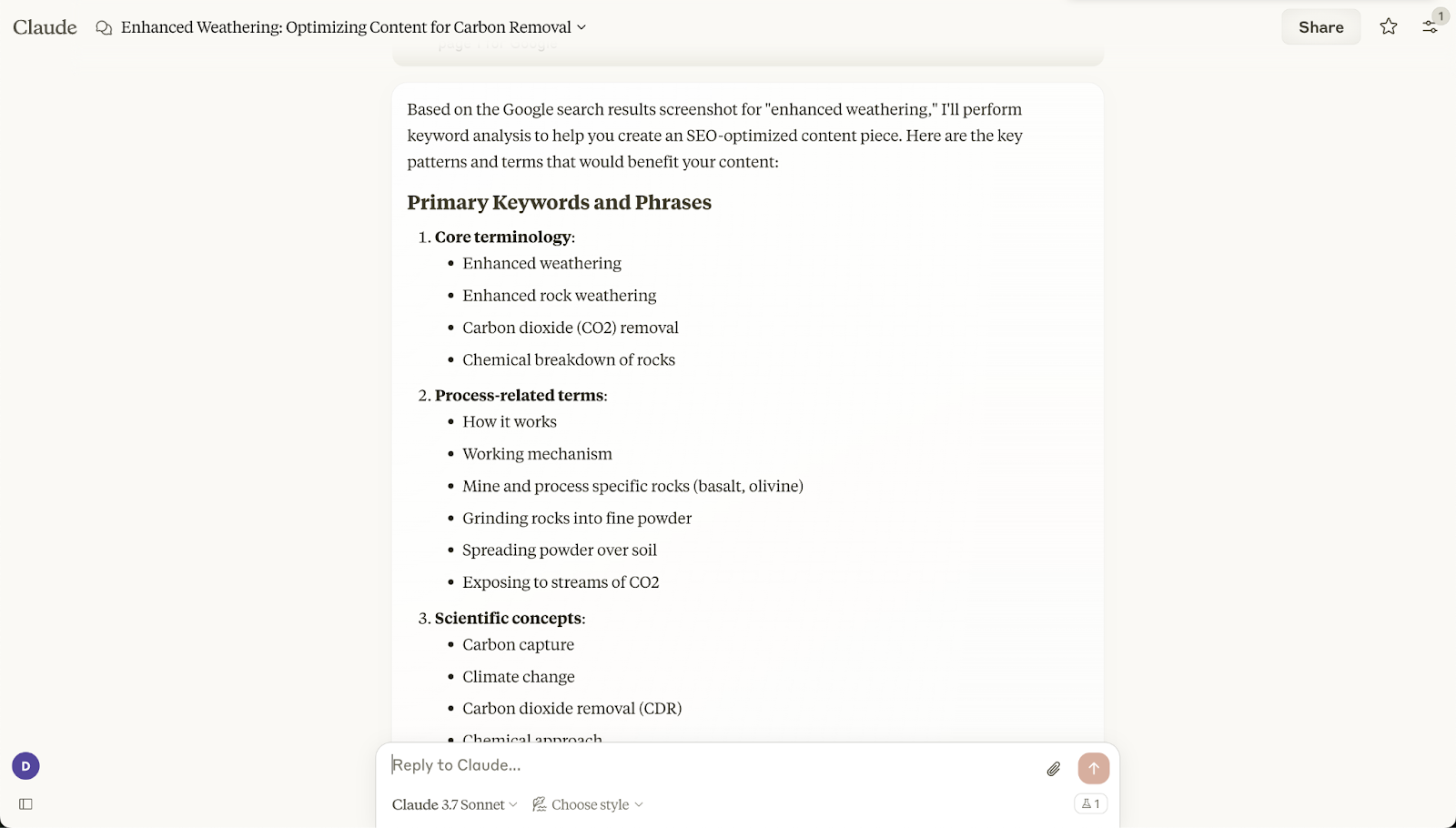
If you don’t like the first answer Claude gives you, try hitting the “Retry” button or providing a follow-up prompt.
Gemini
I asked Google’s Gemini chatbot to provide keyword ideas for a blog post about AI keyword research, and the chatbot provided a large list split into multiple sections:
- Core/Broad Keywords
- Specific AI Tool/Technique Keywords
- Benefit/Outcome Keywords
- “How-To” and Tutorial Keywords
- Comparison/Review Keywords
- Long-Tail Keywords
- Emerging/Trending Keywords
- Local SEO Keywords
- Primary Keywords
- Long-Tail Keywords & Specific Use Cases
- Keywords Related to Benefits
- Keywords Related to Tools
- Keywords Related to the Process
- General SEO & Keyword Research Terms (to attract a broader audience)
The keyword list contains many good suggestions but could be overwhelming for beginners. I’d recommend using a follow-up prompt to narrow your results.
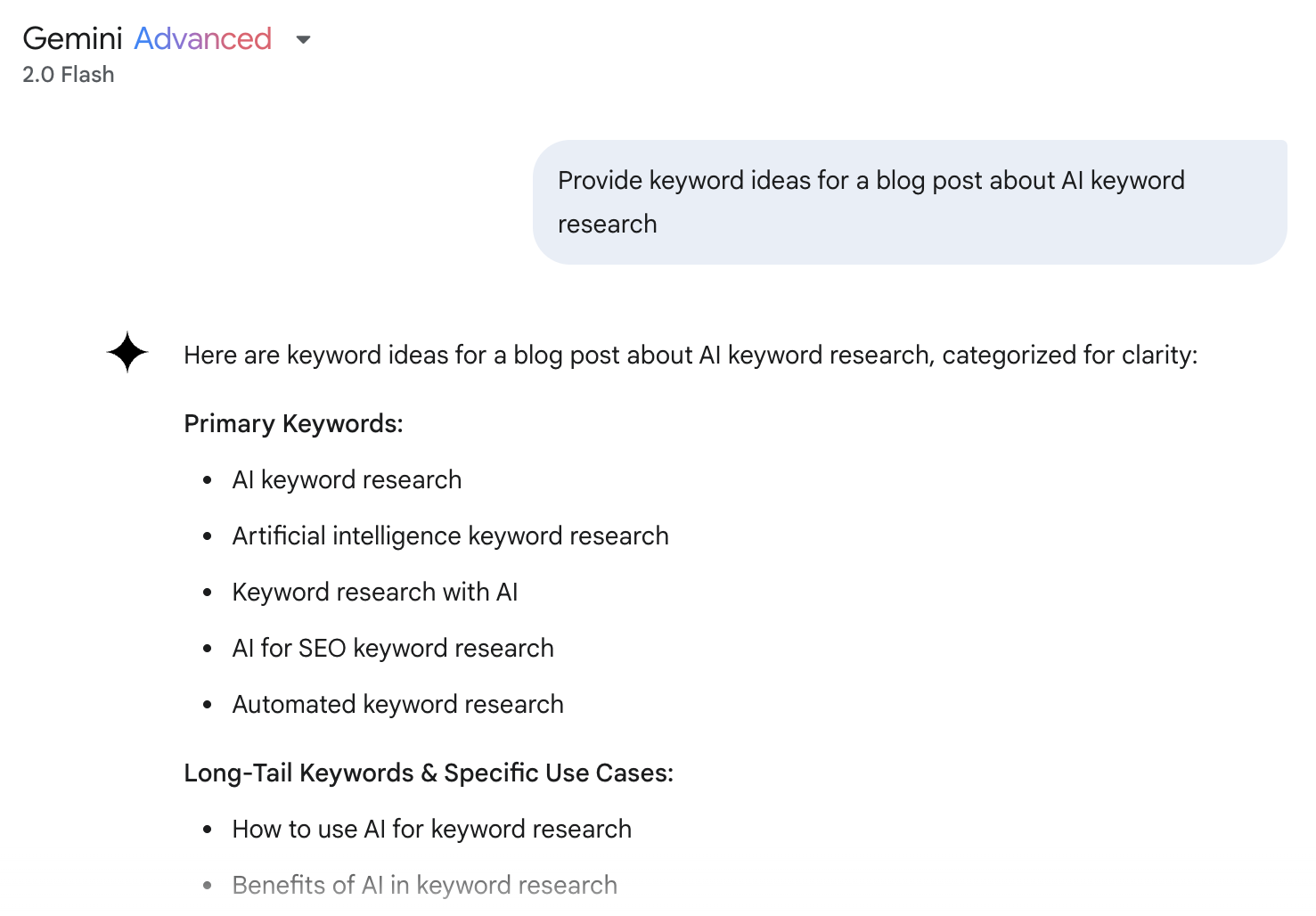
When I asked Gemini to analyze the intent behind “AI keyword research,” the chatbot provided a useful and focused analysis that could help me write an effective blog post.
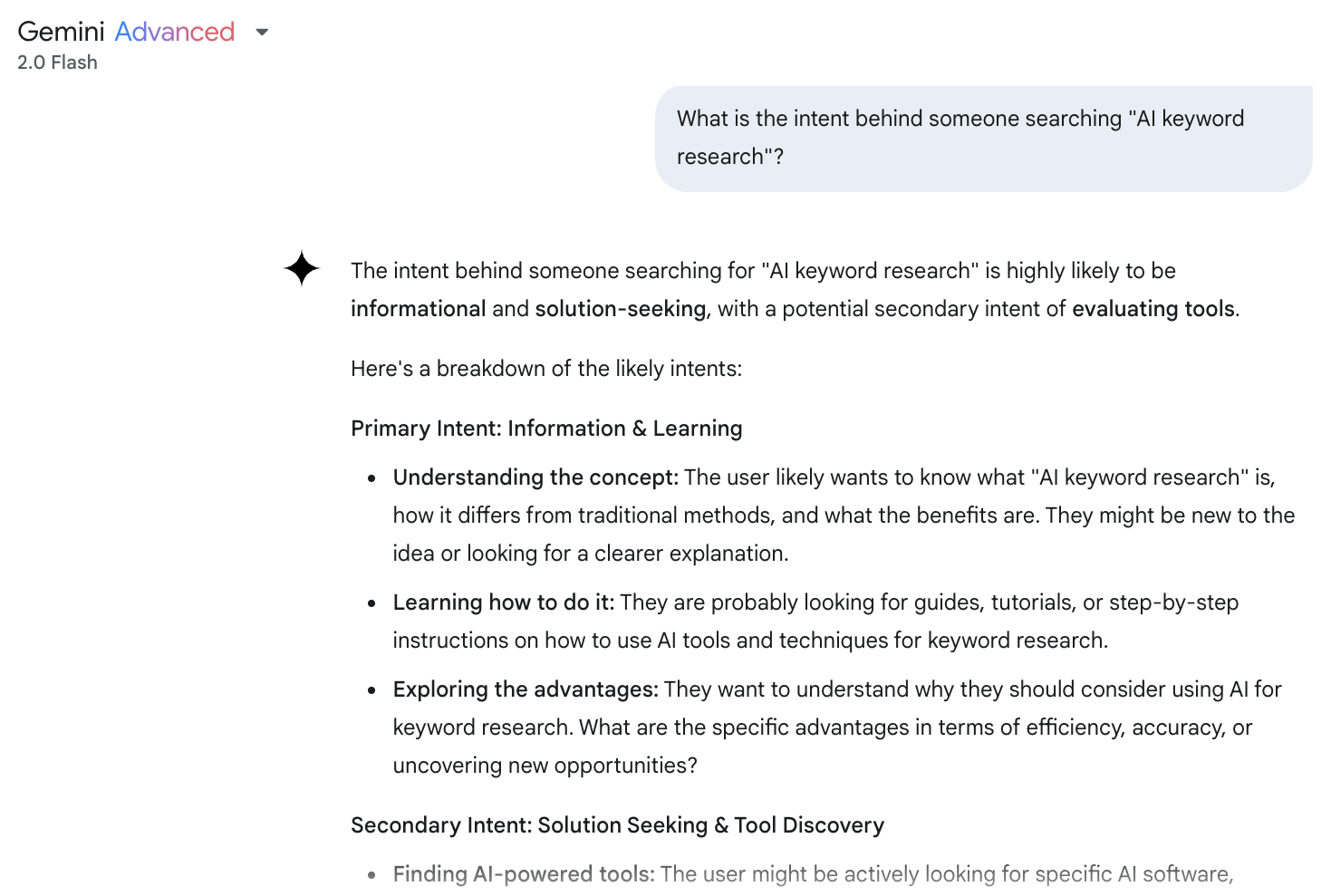
Perplexity
When I asked Perplexity to provide keyword ideas around AI keyword research, the tool shared a list of headline ideas rather than keywords.
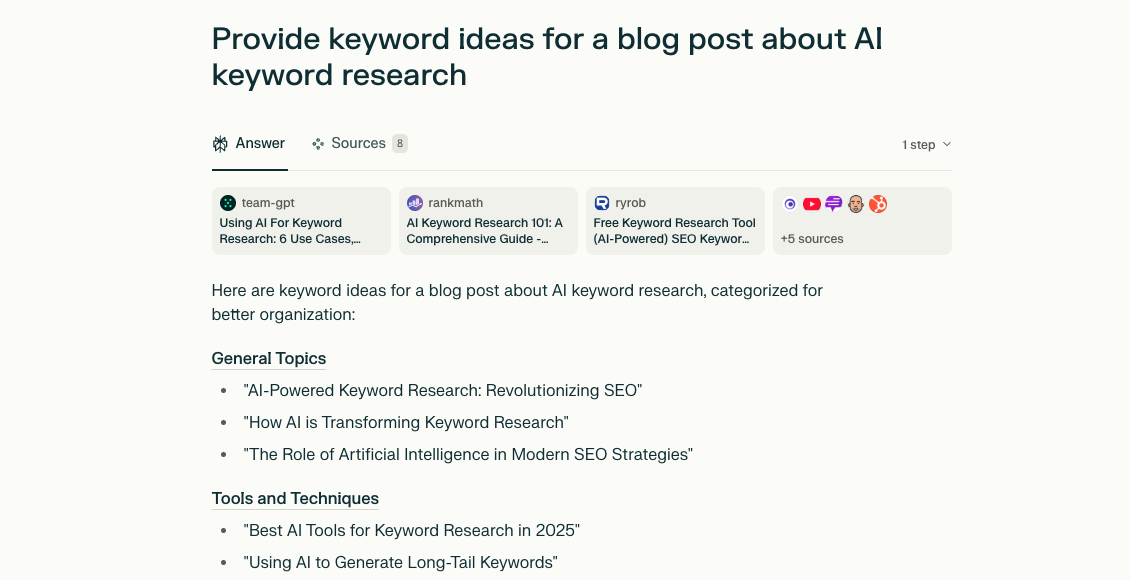
But the AI chatbot provided some good ideas once I clarified the prompt.
One advantage of Perplexity is that it provides a list of web sources by default.
Viewing these sources can provide some useful insight into competing content. Although, it’s better to review top-ranking results on Google’s SERP if that’s where you want to rank.
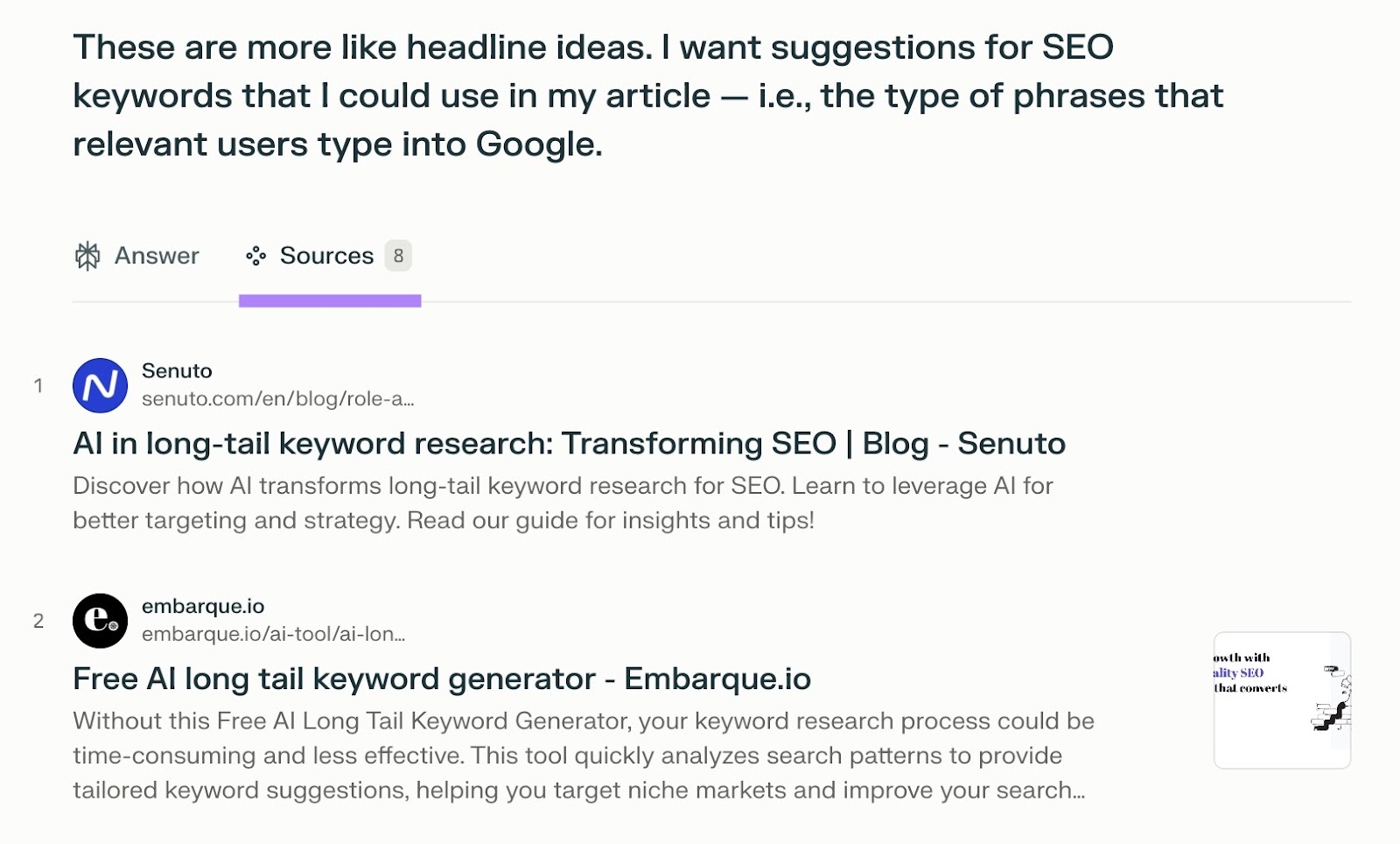
Copilot
Microsoft’s Copilot chatbot generated a list of 15 keywords when I asked for ideas relating to AI keyword research. And while some keywords were a little broad, they were all highly relevant.
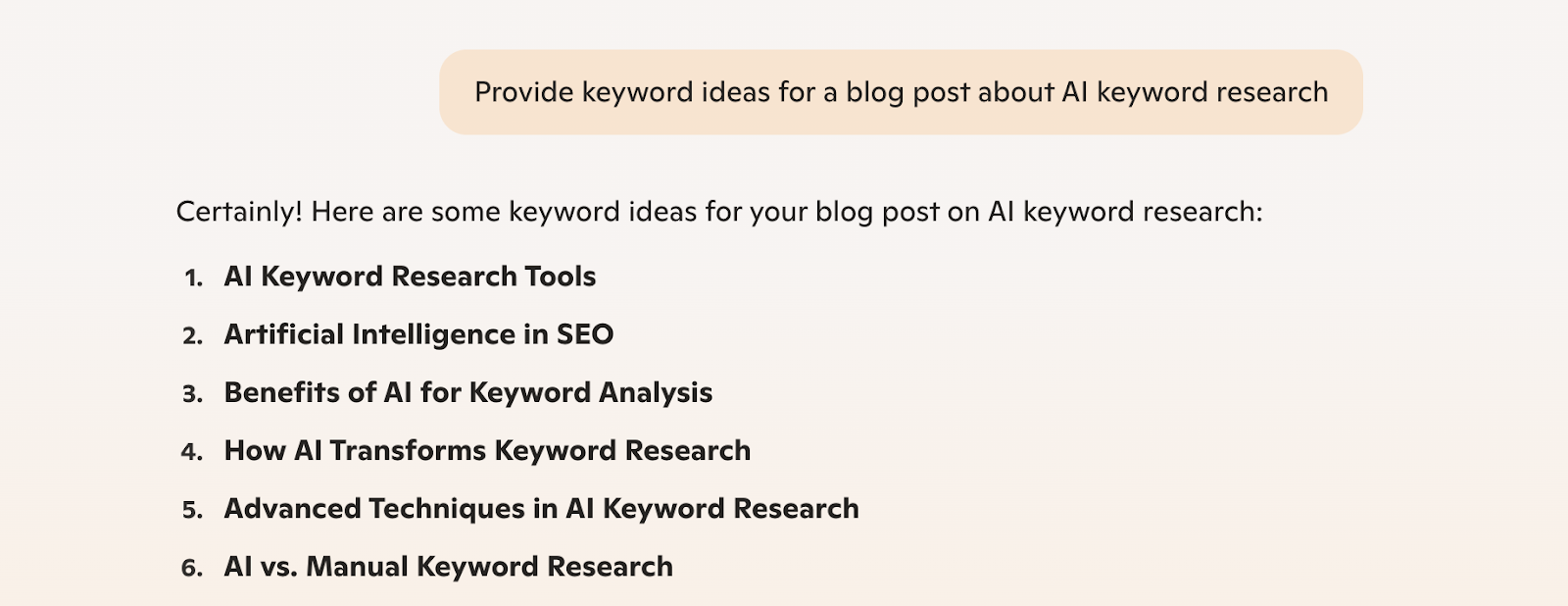
Copilot also provided some good insight into search intent and suggested follow-up prompts to help me clarify my needs.

Using AI Chatbots with Traditional SEO Tools
AI chatbots are good for brainstorming keyword ideas and analyzing search intent, but I recommend using a traditional keyword research tool to validate the keywords you find.
Validating a keyword means checking whether it’s worth targeting based on real-world SEO data.
For example, Semrush’s Keyword Overview tool reveals keyword metrics including:
| Metric | Description | How It’s Calculated |
| Search volume | The average number of searches for the keyword each month | Real search engine data and machine learning algorithms |
| Trend | How actual search volumes have fluctuated over the past year | Real search engine data and machine learning algorithms |
| Personal Keyword Difficulty | A measure of how hard it’ll be for your domain to rank in Google’s top 10 organic results | AI algorithm that considers various factors relating to your domain and top-ranking domains |
| Intent | The type(s) of search intent behind the keyword | Machine-learning algorithm that considers keyword terminology and SERP features shown in search results |
When I used Keyword Overview to analyze 10 primary keywords suggested by ChatGPT, only two keywords had registered search volumes. This doesn’t necessarily mean the other keywords receive zero searches, but it does indicate their popularity is very low.
Keyword Overview also shows that the two keywords with registered search volumes have commercial intent and should be relatively easy for my domain to rank highly for.
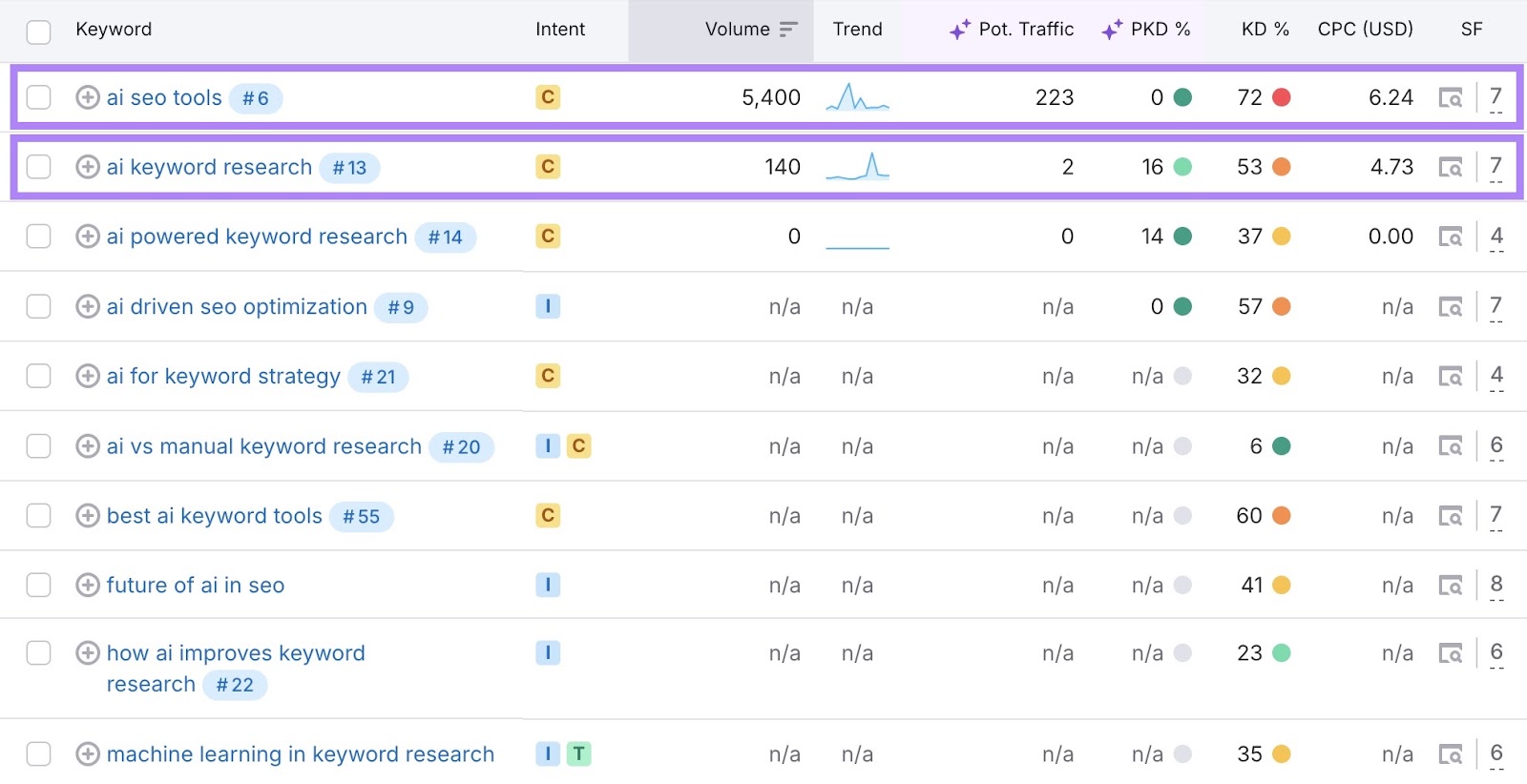
When I analyze a specific keyword in Keyword Overview, I can:
- View additional metrics, such as my potential ranking position

- Gather more keyword ideas and check their associated metrics

- Analyze the Google SERP to see what kinds of results perform well

These kinds of insights help you identify keywords that are likely to drive good results for your website.
Start your free trial to test out Keyword Overview for yourself.
